When talking about trail running shoes, Brooks is a well-admired brand with diverse choices to select from. Two famous models are the Brooks Cascadia and the Brooks Catamount. Both shoes contain their versatile attributes, and athletes may wonder which is the finer option for their requirements.
The Brooks Cascadia is a practical shoe that is less snug but provides more steadiness and aid on challenging trails. It is recommended for athletes with ambitious plans, such as the Western States 100. On the other hand, the Brooks Catamount is a more comfortable shoe that may struggle on demanding terrain but is a perfect option for runners searching for a feathery and absorbent option. The sole unit of the Cascadia features more padding and firmness with BioMoGo DNA material; on the contrary, the Catamount comprises a thinner midsole with customary EVA foam.
The Cascadia also contains a more aggressive outsole with critically placed lugs, while the Catamount features a less combative outsole with fewer lugs.
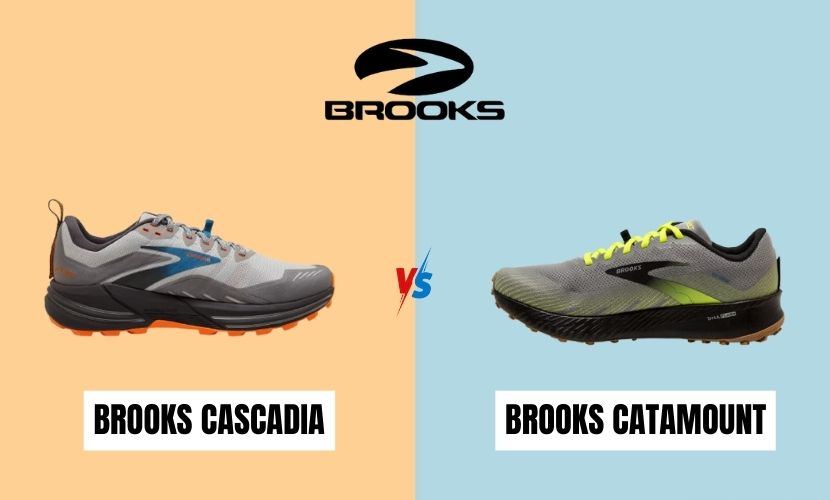
Comparison Table: Brooks Cascadia Vs Brooks Catamount
| Feature | Brooks Cascadia | Brooks Catamount |
| Terrain Adaptability | Ideal for technical and demanding terrains due to aggressive outsole with lugs | Better suited for less challenging terrains with a less aggressive outsole |
| Traction | Excellent grip on damp and skiddy surfaces thanks to lugged outsole | Better grip on dry surfaces |
| Cushioning and Comfort | Whole-length BioMoGo DNA midsole for superior padding and stability | Moderately thinner midsole with EVA foam for a softer feel |
| Fit | Comfortable fit with moderate arch support and a spacious toe box | Generous fit, suitable for athletes with wider feet |
| Durability | Hard-wearing materials with a robust upper | Durable materials, but may have a longer-lasting outsole |
| Weight | Heavier at 11.8 oz, suitable for those who prefer more cushioning | Lighter at 10.3 oz, ideal for speed and agility |
| Stack Height & Heel Drop | 29mm stack height, 8mm heel drop for a balance of padding and responsiveness | 24mm stack height, 6mm heel drop for a lighter and more natural feel |
| Price | Typically more expensive, ranging from $130 to $160 | Generally less expensive, ranging from $110 to $140 |
| Road Running Suitability | Better suited for trail running, less comfortable on roads | More comfortable for both road and trail running |
| Sizing | Runs true to size but may have a tight toe box | Runs true to size but may run slightly small, consider sizing up for a snug fit |
| Hiking Suitability | Limited suitability for long hikes with heavy loads | Limited suitability for technical terrain and may lack adequate stability |
| Pros | Comfortable, durable, protective, and suitable for demanding trails | Lightweight, comfortable, good traction, and versatile for various terrains |
| Cons | Heavier, less flexible, and relatively more expensive | May lack support for technical terrain and has limited color options |
Overview of Brooks Cascadia
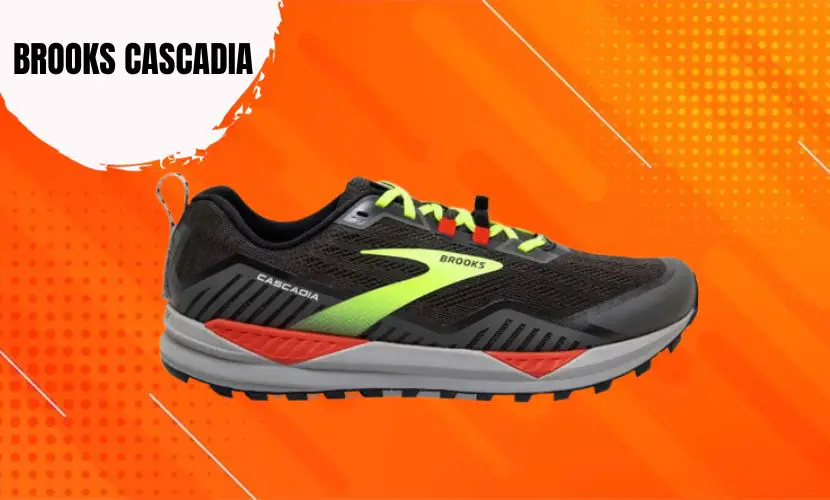
Brooks Cascadia is a famous trail running shoe structured to provide comfort, steadiness, and protection on rough terrain. The shoe is famous for its longevity and versatility, making it a beloved among trail players and hikers.
Features
The Brooks Cascadia offers a whole-length midsole constructed of Brooks’ proprietary BioMoGo DNA material, which gives padding and stability. The shoe also contains an aggressive outsole with decisively placed lugs that provide remarkable grip on challenging trails.
The shoe’s upper is designed of a porous netting material that aids in maintaining the feet excellent, fresh, and dry. The shoe also comprises a rock plate that shields the feet from edgy rocks and other debris on the trail.
Design
The Brooks Cascadia has a customary pattern that is both functional and modish. The shoe is accessible in various colors and has a streamlined, slender look that attracts many players.
The shoe has a moderate level of arch aid and a spacious toe box, which gives ample room for the toes to move around. The shoe also contains a safe fit that maintains the feet comfortable and prevents them from skidding around inside the shoe.
Performance
The Brooks Cascadia is a remarkably rated trail running shoe that functions well on a diversity of terrain. The shoe provides remarkable traction on damp and dry surfaces, and the rock plate provides additional protection on rocky trails.
The shoe is also snug and adaptive, making it a perfect option for long runs and hikes. The padding in the midsole helps to soak up the impact and minimize fatigue, and on the contrary, the absorbent upper maintains the feet cool, fresh, and dry.
Overall, the Brooks Cascadia is a dependable and hard-wearing trail running shoe that is well-matched for various outdoor activities.
Overview of Brooks Catamount
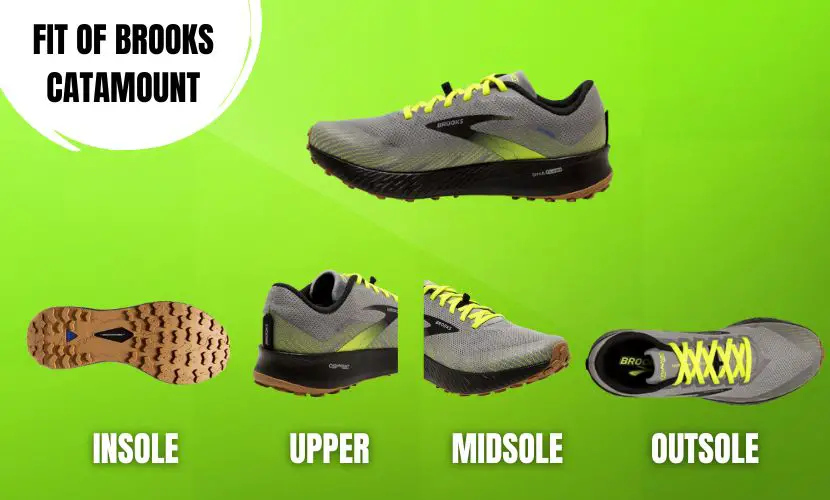
The Brooks Catamount is a trail running shoe launched in 2021 and has rapidly become a famous option among runners. It is structured to be feathery and stretchable, making it perfect for runners who desire to rush on the trails.
Upper
The Catamount has a delicate upper with fewer overlays, giving a more stretchable fit. It has a porous netting upper that permits air to flow around the foot, adjusting it to cool, fresh, and dry. The upper also offers a gusseted tongue that aids in keeping debris out of the shoe.
Midsole
The midsole of the Catamount provides Brooks’ DNA Flash technology, which gives a reactive and springy ride. It has enough padding to support the foot but is not overly mushy, making it an ideal option for runners prioritizing a firmer feel.
The shoe also offers a rock plate that shields the foot from edgy rocks and other problems on the trail.
Outsole
The outsole of the Catamount is designed of a sticky rubber compound that gives remarkable grip on a diversity of surfaces. It offers multi-directional lugs that support the shoe’s grip on the surface, even on steep terrain. The outsole is also structured to be hard-wearing, so runners can anticipate it to last through many miles of use,
Overall, the Brooks Catamount is a perfect option for runners who desire a feathery, stretchable shoe that can control various trail conditions. It features a reactive ride, a good grip, and a solid shield for the foot.
Comparative Analysis
Terrain Adaptability
Both the Brooks Cascadia and Catamount are constructed for trail running. The Cascadia has a combative outsole with critically placed lugs, which makes it perfect for technical and demanding terrains. Conversely, the Catamount comprises a less aggressive outsole with fewer lugs, making it finer suited for less practical terrains.
In the case of traction, the Cascadia offers a better grip on damp and slippery surfaces because of its lugged outsole. However, the Catamount’s outsole gives a better grip on dry surfaces. If you have a scheme for running on technical terrains, the Cascadia may be a better choice; however, the Catamount may be better matched for less challenging terrains.
Cushioning and Comfort
The Brooks Cascadia offers a whole-length midsole structured of Brooks’ proprietary BioMoGo DNA material, which features excellent padding and steadiness. Conversely, the Catamount has a moderately thinner midsole and utilizes a more customary EVA foam. This shows that the Cascadia gives better padding and aid, making it more snug for longer runs.
In the matter of fit, the Cascadia has a comfortable fit, which may need to be more adaptable for runners with broader feet. Conversely, the Catamount features a more generous fit, making it more snug for athletes with extensive feet. If you prefer padding and stability, the Cascadia may be a finer choice; however, the Catamount may be better matched for players with broader feet.
Durability
Both the Brooks Cascadia and Catamount are structured with hard-wearing materials that can resist the deterioration of trail running. However, the Cascadia’s lugged outsole may break down faster than the Catamount’s outsole, mainly if you run on firm surfaces.
Regarding upper durability, both shoes are structured with absorbent and hard-wearing materials that can resist the elements. However, the Cascadia’s upper is more robust, making it better suited for players requiring more shields from rocks and debris.
Material Comparison
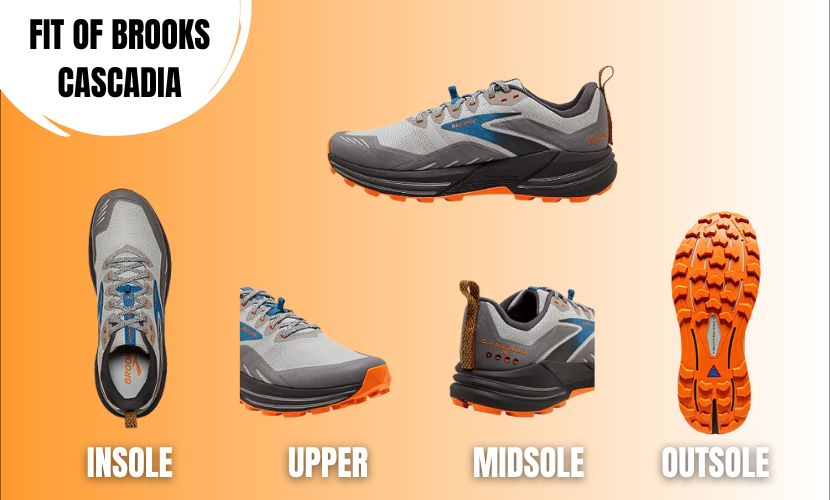
Insole
The insole of the Brooks Cascadia 16 is constructed of BioMoGo DNA foam, which gives padding and support. It is demountable, permitting personalization with orthotics or other inserts. The Catamount 2 also offers a removable insole but is designed with a less complicated foam material.
Midsole
The midsole of the Cascadia 16 is constructed of BioMoGo DNA foam, which is structured to cater to the athlete’s stride and offer padding. It also offers a rock plate for additional protection on stony terrain.
The Catamount 2 contains a thinner midsole structured of EVA foam, which gives a more reactive feel but may provide less padding on longer runs.
Outsole
The outsole of the Cascadia 16 comprises an aggressive pattern with multidirectional lugs for grip on diverse surfaces. It also offers a rock plate for additional protection.
The Catamount 2 contains a less aggressive outsole with fewer lugs, which may offer a more snug ride on even terrain but less grip on more practical trails.
Upper
The upper of the Cascadia 16 is designed of a durable netting material with fabricated overlays for additional support. It offers a gusseted tongue to block out debris and a protective toe cap. The Catamount 2 contains a similar upper pattern with a porous mesh material and fabricated overlays, but it does not contain a gusseted tongue or toe cap.
Overall, the Brooks Cascadia 16 and Catamount 2 contain similar material formations, with the Cascadia 16 featuring more padding and protection. On the other hand, the Catamount 2 features a more reactive ride.
Price Comparison
Regarding price, the Brooks Cascadia and Catamount contain several dissimilarities worth noting. The Brooks Cascadia is typically more costly than the Catamount, but the cost difference may differ based on the particular model and where you buy them from.
The Brooks Cascadia generally costs approximately $130 to $160; on the other hand, the Catamount costs around $110 to $140. The exact cost may differ based on the color and size of the shoe. The Cascadia is a more structured shoe and has been in the market for longer, which may add to its fantastic price point.
While the Cascadia may be more costly, it does feature some extraordinary attributes that may justify the more significant price for some athletes. For instance, the Cascadia has a massive sole with a rock plate, which gives more padding and protection against stony terrain. The Catamount, on the other side, contains a thinner sole and is structured to be more feathery.
If you’re searching for a more established shoe with a massive sole and are okay with paying more, the Cascadia may be your finer choice. However, if you’re searching for a more economical and delicate shoe, the Catamount may be the way to go.
Weight Comparison
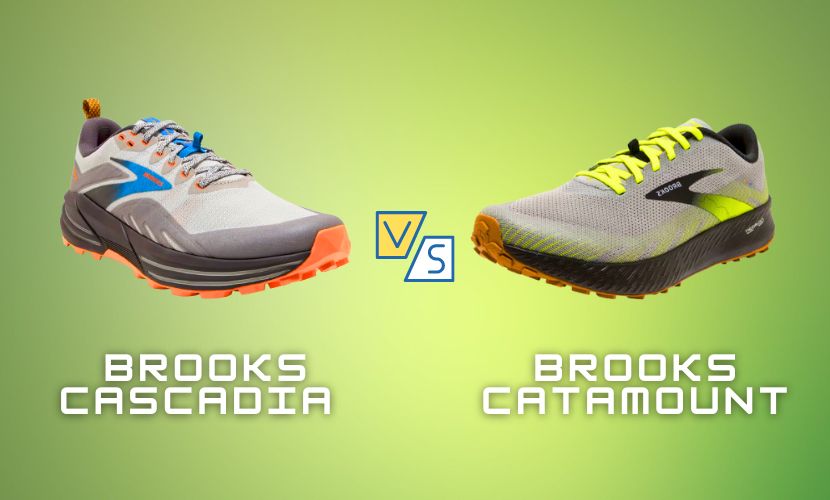
When contrasting the Brooks Cascadia and the Catamount, weight is an efficient factor to contemplate. A shoe’s weight can influence a runner’s performance, particularly during long-distance runs.
The Brooks Cascadia comprises a weight of 11.8 oz; on the other hand, the Catamount is moderately lighter at 10.3 oz. This shows that the Catamount is more feathery than the two shoes, which may make it a finer option for athletes who prefer speed and agility.
However, it’s worth mentioning that the Cascadia features more padding than the Catamount, which can be advantageous for runners who require extra support and ease during their runs. The additional padding may also add to the Cascadia’s moderately heavier weight.
In summary, the Catamount is the more delicate of the two shoes; conversely, the Cascadia features more cushioning. Players should consider their priorities and requirements when selecting between these two designs.
Stack Height & Heel Drop
One of the most obligatory aspects to consider when selecting a trail running shoe is the stack height and heel drop. The stack height refers to the quantity of padding between the foot and the ground; on the other side, the heel drop refers to the dissimilarity in height between the heel and forefoot.
The Brooks Cascadia contains a stack height of 29mm under the heel, giving adequate padding for long runs on practical trails. It also offers a rock plate for additional protection against edgy rocks and roots. The heel drop of the Cascadia is 8mm, a mild drop that can offer an ideal balance between padding and reactiveness.
Conversely, the Brooks Catamount has a deeper stack height of 24mm under the heel, making it a more delicate and reactive shoe. It also comprises a lower heel drop of 6mm, which can encourage a more natural stride and finer ground feel.
Several athletes may prioritize a shoe with more padding and a more significant drop for additional comfort on long runs; on the other hand, others may agree on a lighter and more reactive shoe with a more profound drop for finer agility and speed.
In summary, the Brooks Cascadia features a greater stack height and mild heel drop for a balance of padding and reactiveness; on the other side, the Brooks Catamount has a deeper stack height and drop for a delicate and more natural feel.
Pros and Cons of Brooks Cascadia
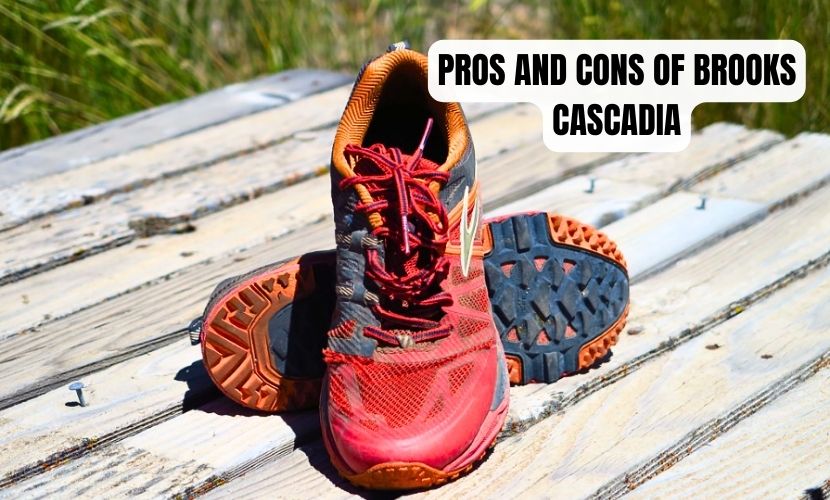
Pros of Brooks Cascadia
Brooks Cascadia is a famous trail running shoe popular for its ease and protection. Following are several pros of Brooks Cascadia:
- Comfortable: Brooks Cascadia is structured with ease in mind. It comprises a mushy and padded midsole that gives a snug ride on rough terrain.
- Durable: Brooks Cascadia is constructed to last. It comprises a sturdy outsole with remarkable grip and is resistant to deterioration.
- Protective: Brooks Cascadia contains a rock plate that shields your feet from edgy rocks and other debris on the trail.
- Waterproof: The Cascadia also features a waterproof version, ideal for damp and muddy conditions.
- Breathable: The Cascadia has an absorbent netting upper that allows air to flow, keeping your feet cool, fresh, and dry.
Cons of Brooks Cascadia
While Brooks Cascadia contains many pros, there are also several cons to contemplate:
- Heavy: Brooks Cascadia is not the industry’s most delicate trail running shoe. It has a massive, heavy sole that makes it feel bulky on the trail.
- Stiff: The rock plate and rigid sole of the Cascadia can make it feel less stretchable and natural than other trail running shoes.
- Expensive: Brooks Cascadia is not the most economical trail running shoe. It costs more than several of its competitors.
- Limited color options: Brooks Cascadia has a restricted selection of color choices, which may be a drawback for those who desire a more customized look.
Brooks Cascadia is a rigid option for trail runners who prefer comfort, longevity, and protection. However, it may be challenging for those who desire a delicate and flexible shoe.
Pros and Cons of Brooks Catamount
Pros of Brooks Catamount
The Brooks Catamount is a trail running shoe with several advantages to players. The following are several pros of Brooks Catamount:
- Lightweight: The Brooks Catamount is a delicate shoe perfect for trail running. It weighs approximately 10.3 oz, making it easy to wear for elongated distances.
- Comfortable: The shoe comprises a comfortable fit that maintains the foot in position and averts slipping. The upper is absorbent, which aids in maintaining the feet excellent, fresh, and dry during long runs.
- Good Traction: The outsole of the Brooks Catamount gives remarkable grip and traction on different terrains, incorporating rocky and muddy trails.
- Supportive Cushioning: The shoe comprises a reactive midsole with good padding and support, making it snug to wear for extended periods.
Cons of Brooks Catamount
While the Brooks Catamount has some advantages, it also has some advantages. The following are several cons of Brooks Catamount:
- Not Suitable for Technical Terrain: The shoe needs to be better suited for technical terrain, as it needs more stability and protection.
- Limited Color Options: The Brooks Catamount is only accessible in a limited quantity of colors, which may not match everyone’s preferences.
- Price: The Brooks Catamount is expensive compared to other trail running shoes in the industry, which may need to be more adaptable for players on a budget.
Overall, the Brooks Catamount is a perfect trail running shoe with several advantages to runners. While it may not be ideal for technical terrain, it gives remarkable traction, aid, and comfort for long-distance trail running.
Top Models of Brooks Catamount
Brooks Catamount is a renowned trail running shoe that has attracted much attention from the running industry. It is famous for its lightweight pattern, excellent grip, and snug fit. Following are several top models of Brooks Catamount:
Brooks Catamount
The Brooks Catamount is the genuine model of the Catamount series. It offers a delicate design that makes it ideal for trail running.
The shoe comprises a porous upper that maintains the foot cool, fresh, and dry and a reactive midsole that gives excellent padding and aid. The outsole of the Catamount is structured of durable rubber that features remarkable grip on different terrains.
Brooks Catamount 2
The Brooks Catamount 2 is an updated version of the original Catamount. It offers a more reactive midsole that gives finer padding and support.
The shoe also contains an advanced upper that is more porous and comfortable. The outsole of the Catamount 2 is durable rubber, featuring outstanding grip on various terrains.
Brooks Catamount Gaiter
The Brooks Catamount Gaiter is a versatile version of the Catamount that is available with a built-in gaiter. The gaiter aids in maintaining debris out of the shoe, making it ideal for trail running.
The shoe offers a lightweight pattern and an absorbent upper that keeps the foot cool, fresh, and dry. The midsole of the Catamount Gaiter gives remarkable padding and support; on the contrary, the outsole is designed with durable rubber that gives outstanding traction on different terrains.
Overall, the Brooks Catamount series features remarkable trail running shoes ideal for runners of all standards. Each model has its versatile features and advantages, so players can select the one that best suits their requirements.
Top Models of Brooks Cascadia
Brooks Cascadia has been a famous trail running shoe in the industry for over a decade. It has revolutionized over the years, and the newest models offer remarkable performance and ease for trail runners. Following are several top models of Brooks Cascadia:
Brooks Cascadia 16
The Brooks Cascadia 16 is the newest model in the Cascadia series. It contains a snug fit and provides an outstanding grip on distinct terrains. The shoe offers a rock plate that shields the foot from edgy rocks and roots. The upper is designed with a porous netting that maintains the foot cool, fresh, and dry.
The Cascadia 16 comprises an 8mm heel-to-toe drop and a stack height of 29mm under the heel. It is an iconic shoe that can control different kinds of trails, from technical to smooth. The shoe weighs 11.5 ounces for men and 9.8 ounces for women.
Brooks Cascadia 15
The Brooks Cascadia 15 is the forerunner of the Cascadia 16. It is a dependable trail running shoe that gives remarkable protection and ease. The shoe features an 8mm heel-to-toe drop and a stack height of 27mm under the heel.
The Cascadia 15 contains a durable outsole that gives excellent grip on distinct terrains. The upper is composed of a porous meshkeepsntains the foot cool, fresh, and dry. The shoe comprises a weight of 11.7 ounces for men and 9.8 ounces for women.
Brooks Cascadia 14
The Brooks Cascadia 14 is a famous trail running shoe with outstanding comfort and protection. The shoe contains an 8mm heel-to-toe drop and a stack height of 27mm under the heel. It offers a rock plate that shields the foot from edgy rocks and roots.
The Cascadia 14 has a hard-wearing outsole with excellent grip on various terrains. The upper is designed with a porous netting that maintains the foot cool, fresh, and dry. The shoe weighs 11.7 ounces for men and 9.8 ounces for women.
Brooks Cascadia 13
The Brooks Cascadia 13 is an older design in the Cascadia series, but it is still a dependable trail running shoe. It comprises a 10mm heel-to-toe drop and a stack height of 27mm under the heel. The shoe offers a rock plate that shields the foot from edgy rocks and roots.
The Cascadia 13 has a hard-wearing outsole with excellent grip on distinct terrains. The upper is designed with an absorbent mesh that maintains the foot cool and dry. The shoe weighs 12.3 ounces for men and 10.7 ounces for women.
Overall, Brooks Cascadia is a dependable trail running shoe that gives remarkable protection and ease for trail runners. The newest models, like the Cascadia 16, provide advanced performance and longevity.
Is Brooks Catamount Suitable for Hiking?
The Brooks Catamount is a trail running shoe with a feathery feel, stable, supportive cushion, and firm protection against rocks. However, it is also efficient to consider whether it is adaptable for hiking.
One of the significant advantages of the Brooks Catamount is its delicate feel. This can benefit hiking as it permits a more agile and acrobatic movement on the trail. However, the shoe is designed for running and may offer little support and steadiness for long hikes with massive loads.
The fit of the Brooks Catamount is comfortable in the front from top to bottom, which maintains the foot from moving forward or skidding. This can be advantageous for hiking as it gives a safe fit and averts blisters and other foot injuries. The generous D width also lodges wider feet snugly.
The grip of the Brooks Catamount is adaptable for mild trails, practical trails, muddy areas, creeks, and streams. However, it may need to offer more grip for steep or skiddy terrain frequently encountered during hiking.
In conclusion, while the Brooks Catamount has some hiking advantages, it is structured for trail running. It may offer little aid and steadiness for long hikes with heavy loads. It is necessary to consider the terrain and states of the hike before determining whether the Brooks Catamount is ideal footwear.
Which runs true to size? – Brooks Cascadia vs. Catamount
It is efficient to consider the fit when selecting the right trail running shoe. A shoe that runs too tiny or large can cause discomfort, blisters, and even injury. In this part, we will contrast the sizing of the Brooks Cascadia and Catamount designs.
The Brooks Cascadia goes true to size. This shows that most athletes can select their regular shoe size and anticipate a comfortable fit. However, the Cascadia has a moderately tight toe box, which may be better for athletes with wider feet.
On the other hand, the Brooks Catamount contains a looser upper that lodges broader feet without compromising on fit for others. However, several athletes have mentioned that the Catamount runs small, so it may be obligatory to size up for a snug fit.
To aid you in detecting the perfect size for you, the following are the sizing charts for the Brooks Cascadia and Catamount:
Brooks Cascadia Sizing Chart
| US Size | EU Size | UK Size | Foot Length (inches) |
| 7 | 40 | 6 | 9.84 |
| 7.5 | 40-41 | 6.5 | 10.04 |
| 8 | 41 | 7 | 10.24 |
| 8.5 | 42 | 7.5 | 10.43 |
| 9 | 42-43 | 8 | 10.63 |
| 9.5 | 43 | 8.5 | 10.83 |
| 10 | 44 | 9 | 11.02 |
| 10.5 | 44-45 | 9.5 | 11.22 |
| 11 | 45 | 10 | 11.42 |
| 11.5 | 46 | 10.5 | 11.61 |
| 12 | 46-47 | 11 | 11.81 |
| 12.5 | 47 | 11.5 | 12.01 |
| 13 | 48 | 12 | 12.20 |
Brooks Catamount Sizing Chart
| US Size | EU Size | UK Size | Foot Length (inches) |
| 7 | 40 | 6 | 9.84 |
| 7.5 | 40-41 | 6.5 | 10.04 |
| 8 | 41 | 7 | 10.24 |
| 8.5 | 42 | 7.5 | 10.43 |
| 9 | 42-43 | 8 | 10.63 |
| 9.5 | 43 | 8.5 | 10.83 |
| 10 | 44 | 9 | 11.02 |
| 10.5 | 44-45 | 9.5 | 11.22 |
| 11 | 45 | 10 | 11.42 |
| 11.5 | 46 | 10.5 | 11.61 |
| 12 | 46-47 | 11 | 11.81 |
| 12.5 | 47 | 11.5 | 12.01 |
| 13 | 48 | 12 | 12.20 |
Overall, both the Brooks Cascadia and Catamount designs run true to size for most athletes. However, it is efficient to consider the appearance of your feet and any particular fit problems you may have when choosing a size.
Which is suitable for road running? – Brooks Cascadia vs. Catamount
When searching for road running shoes, the Brooks Catamount is the finer choice. The Catamount is structured to be more snug and iconic, making it perfect for both road and trail running.
The Brooks Cascadia, on the other side, is more practical and structured specifically for trail running. It has a rigid sole and a shield against rocks and other obstacles. While it can be utilized for road running, it may not be as snug as the Catamount.
The following are several significant attributes of each shoe that make them perfect for road running:
Brooks Cascadia
- Rigid sole for finer grip on uneven surfaces
- It gives more protection against rocks and other problems
- Durable and hard-wearing
Brooks Catamount
- More snug and iconic for both road and trail running
- Finer cushioning and aid for long-distance runs
- Feathery and porous mesh upper for additional comfort
Overall, the Brooks Catamount is the finer option if you plan on performing a lot of road running. It features superior ease and aid while still being classic enough for trail running if required. However, if you plan on basically trail running with occasional road running, the Brooks Cascadia may be a superior fit for you.
Conclusion
The Cascadia is a more practical shoe with a combative outsole and whole-length BioMoGo DNA midsole, giving padding and steadiness. It’s a perfect option for runners with ambitious plans on demanding trails, just as the Western States 100.
Conversely, the Catamount is a more snug shoe with a moderately thinner midsole made of customary EVA foam. It contains a less aggressive outsole with fewer lugs, making it a finer option for runners who prefer ease over technicality.
In the matter of design aesthetics, both shoes offer extraordinary qualities. The Cascadia has a more uneven and durable appearance; on the contrary, the Catamount has a streamlined and more modern pattern.
Read more on:




